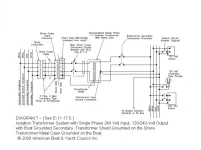brico
Well-known member
- Joined
- Dec 25, 2013
- Messages
- 311
- Status
- OWNER - I own a Hatteras Yacht
- Hatteras Model
- 37' CONVERTIBLE (1977 - 1982)
Hi, I opened up my shore power connection box to check the wiring and see if there is merit in replacing the "shotgun" fuses with newer style breakers as my transparent fuse covers are cracked and a bit "weathered'. As I opened it up I noted that the green "Ground" wire was not connected at the back of the shore power "G" connector terminal and that it was taped over by electrical insulating tape. Would anyone have any suggestion why would someone not connect the boat's AC supply power ground wire at the "G" terminal on the back of the shore connector plug?
Also, I am not really good with electricity and got a bit confused looking at the AC supply power wiring arrangement. I noted that one fuse is on the Phase wire and one is on Neutral wire. I have read somewhere that the only reason why one would fuse both Phase and Neutral wires is if there is possibility of polarity reversal. That is, where the phase and neutral conductors could be interchanged on the supply side of the fuse. If polarity reversal is possible, then double-fusing guarantees that the phase conductor will always be provided with a fuse.
Is there a possibility to interchange the Phase and Neutral on boat's shore power connection if all three pins/slots (male/female sides) on the shore power cable connectors are different shape and size and cannot be interchanged?
Any insight and suggestions are welcome.
Also, I am not really good with electricity and got a bit confused looking at the AC supply power wiring arrangement. I noted that one fuse is on the Phase wire and one is on Neutral wire. I have read somewhere that the only reason why one would fuse both Phase and Neutral wires is if there is possibility of polarity reversal. That is, where the phase and neutral conductors could be interchanged on the supply side of the fuse. If polarity reversal is possible, then double-fusing guarantees that the phase conductor will always be provided with a fuse.
Is there a possibility to interchange the Phase and Neutral on boat's shore power connection if all three pins/slots (male/female sides) on the shore power cable connectors are different shape and size and cannot be interchanged?
Any insight and suggestions are welcome.
Last edited:


